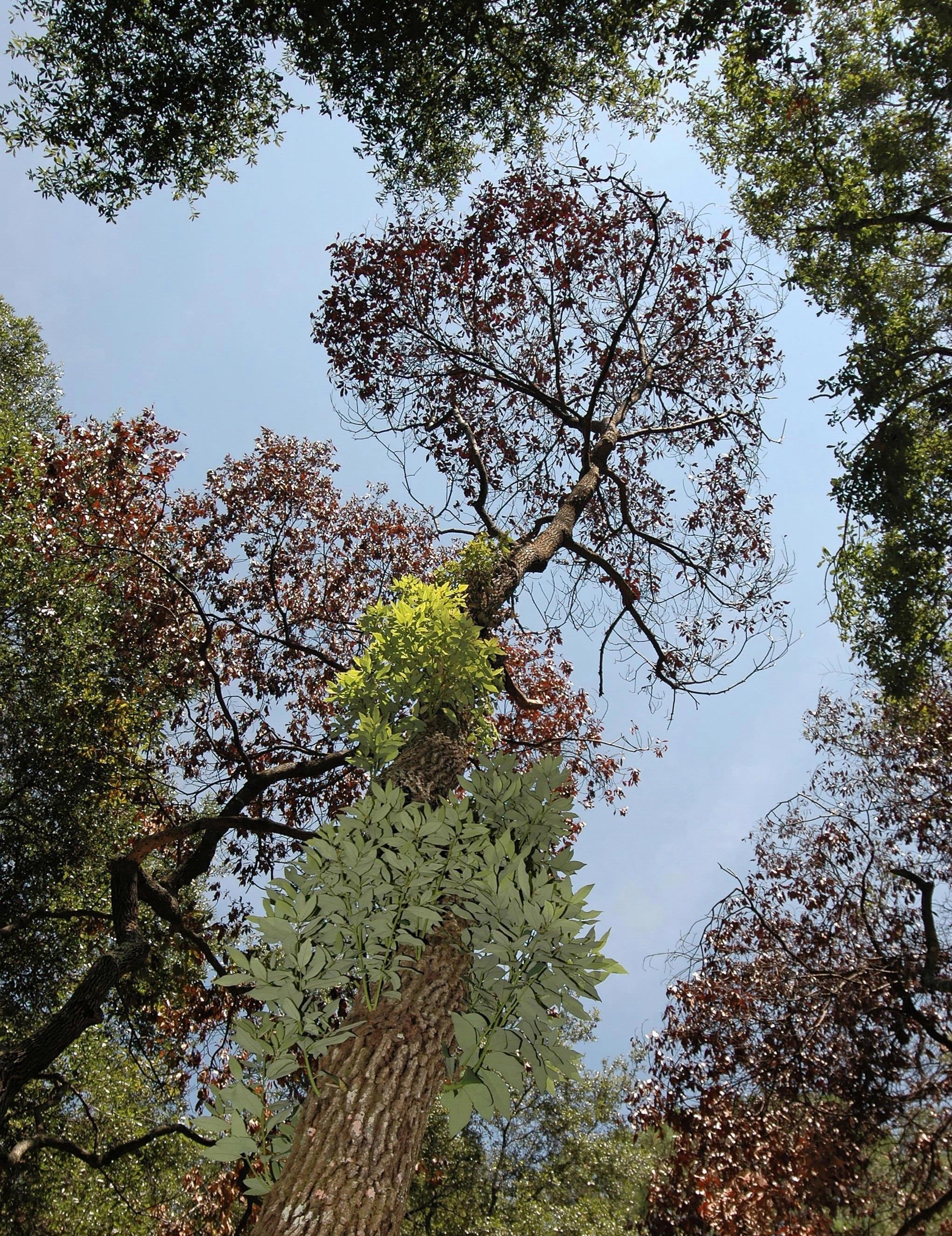Laurel Wilt Disease in Arkansas
Laurel wilt (Raffaelea lauricola sp. nov. T.C. Harr., Fraedrich & Aghayeva (Ascomycota: Ophiostomatales)) is a disease caused by a fungal pathogen affecting many plants in the laurel family (Lauraceae). The laurel wilt fungus is native to Asia and apparently entered the U.S. in solid wood packing material infested with redbay ambrosia beetles (Xyleborus glabratus Eichhoff (Coleoptera: Curculionidea: Scolytinae)) which carry the fungus. The disease was first confirmed in Arkansas in 2015. Some trees or shrubs in the laurel family are more susceptible than others, although susceptibility of the different laurels is not well understood yet. Three trees and shrubs from the laurel family currently grow in Arkansas: sassafras (Sassafras albidum (Nutt.) Nees), northern spicebush (Lindera benzoin (L.) Blume), and southern spicebush (Lindera melissifolia (Walter) Blume).

What is laurel wilt disease?
- Laurel wilt disease is a fungal disease spread by the redbay ambrosia beetle
- The laurel wilt disease fungus is believed to be native to Asia
- Sassafras is Arkansas’s only native tree susceptible to laurel wilt disease
- Laurel wilt disease was first identified in North America around Savannah, GA, in 2002
- Laurel wilt disease was first identified in Arkansas in 2015
Read more about laurel wilt disease
Image courtesy of James Johnson, Georgia Forestry Commission, Bugwood.org

What are the symptoms of laurel wilt disease?
- Leaves in the upper crown droop and turn reddish to purplish
- In later stages the entire crown wilts
- Stiff strings of “sawdust” protruding from the bark
- Redbay ambrosia beetle galleries immediately under the bark
- Dark fungal infections in the sapwood
Image courtesy of Ronald F. Billings, Texas A&M Forest Service, Bugwood.org
Read more about the symptoms of laurel wilt disease

Who spreads laurel wilt disease?
- Laurel wilt disease is spread by the redbay ambrosia beetle, a native of Asia
- Redbay ambrosia beetle probably came to the U.S. in solid wood packing material
- People move laurel wilt disease by moving logs infested with redbay ambrosia beetles
Image courtesy of R. Scott Cameron, Advanced Forest Protection, Inc., Bugwood.org
Find out more about how laurel wilt disease is spread

How will laurel wilt disease affect you?
- Loss of sassafras from our ecosystems and yards
- Loss of the endangered pondberry
- Even though they are not an Arkansas crop, potential loss of avocados from store shelves
Image courtesy of Dow Gardens, Bugwood.org
Learn more about the impact of laurel wilt disease on you

What can we do about laurel wilt disease?
- Don’t move sassafras wood with bark still attached
- Report sassafras showing laurel wilt disease symptoms to your county extension agent
- Currently there is no treatment for laurel wilt disease
Image courtesy of Ronald F. Billings, Texas A&M Forest Service, Bugwood.org
Learn to prevent the spread of laurel wilt disease
Where is laurel wilt disease?
- Laurel wilt disease is native to Asia
- Laurel wilt is spread through the Atlantic coastal plain from North Carolina to Georgia
- Laurel wilt disease is spread through most of Florida
- Laurel wilt occurs at scattered sites in Alabama, Mississippi, Arkansas, Louisiana and Texas
Image courtesy of Chip Bates, Georgia Forestry Commission
Find the locations of laurel wilt disease infestations
Resources
Biology, Ecology, and Management of Laurel Wilt and the Redbay Ambrosia Beetle
Distribution and Spread of Laurel Wilt Disease in Georgia
Ecological Implications of Laurel Wilt Infestations on Everglades Tree Islands, Southern Florida
Forest and Shade Tree Pests: Laurel Wilt
Laurel Wilt: A New Forest Disease in Florida
Laurel Wilt: An Invasive Pest of Sassafras in Arkansas
Laurel Wilt, A Deadly Killer of Lauraceae in the U.S.
Videos
Web Sites
An Undefended Buffett: The Unnecessary Extinction of the Redbay, a Defining Southern Tree
Texas Invasive Species Institute: Laurel Wilt
Southern Regional Extension Forestry: Laurel Wilt
A Brief Summary of Laurel Wilt Disease in Florida and the Southeastern United States
Don't Move Firewood: Laurel Wilt
Leaves As a Clue: Surveying for Laurel Wilt Disease
First Report of Laurel Wilt Caused by Raffaelea lauricola on Sassafras in Mississippi
